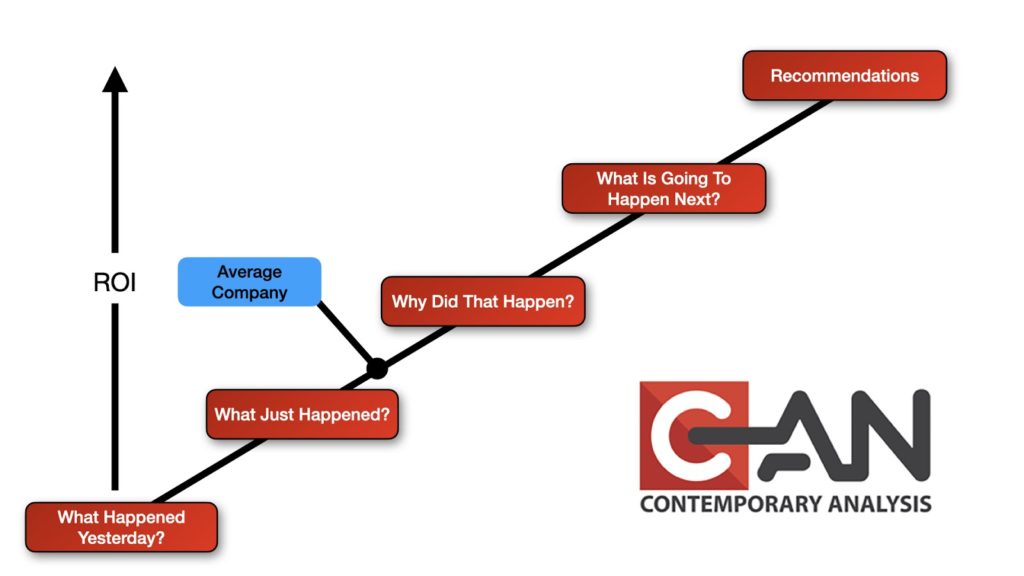The Blind Men and the Elephant
If you rely on analysts to make your decisions, and analysts are blind to everything but their own data, maybe you need a new kind of analyst.
There is a very old parable found in East Asian texts, (and also a 19th century poem) that essentially goes:
A king and his entourage were camped in the desert. The king had brought with him an elephant, which he used to increase the people’s awe. In the next town over, was a group of blind men, who, upon hearing about the strange animal said, “Let us go and investigate”.
So, they sought it out, and when they found it, they groped about it. Each thought they knew something, because he could feel part of the animal.
The man whose hand touched the elephant’s ear exclaimed, “It is a large, rough thing, wide and broad, like a rug.
The man whose hand found the elephant’s trunk said. “I have the real facts about it. It is like a straight and hollow pipe.”
A third who felt the feet and legs said, “It is a huge pillar!”
Each had felt only a part of the whole.
Each had perceived the whole animal wrong.
Most companies have analysts tasked with reporting data about their “part of the whole”. Their interpretation of the data makes their way to the CEO via reports and dashboards so the CEO can be informed and make data-driven decisions. The problem with this system is analysts are blind to what the whole animal is. They interpret the data, not on what the animal is, but what they perceive it to be. Ask any sales person what the most important part of a company is and they will tell you sales, marketing-marketing, operations-operations. This misunderstanding of the whole animal, i.e. the whole system, is costing your company millions in value, revenue, and profit.
Your missing a piece
The reason you are missing millions in value, revenue, and profit, is because you are missing a critical piece of infrastructure–a new kind of employee tasked with looking at data from the entire elephant and finding improvements, creating proactive insight (What is going to happen in the future), and producing value to the bottom line.
This person, when added to your repertoire, will give you an advantage over your competition. However, this new kind of employee is hard to find, and even when you can find them, retaining them is even harder. However, if you take the time to find and integrate these employees, the ROI on what these individuals find is usually in the millions of dollars. Millions. And no one has this skill set except them.
But what do they do? How do they help you produce more value, more EBITDA, and more trust from your board?
Information doesn’t equal insight
The reason the missing piece isn’t an analyst is that what you are missing isn’t information–what you’re missing is insight. For decades, consultants and software companies have preached that you need “Data-Driven Decision Making” to be viable long term. That meant hiring analysts to give you better data. Better Data=Better Decisions. But that was only the first step. Data-Driven Decision Making is only but a part of a much larger Continuum called Data Science.
The Continuum of Data Science is a path of renewed understanding, improvement, and exploration–an ever expanding action-item list of increasingly more complex items, each with greater and greater ROI.
What the Continuum of Data Intelligence looks like:
Data Driven Decisions (complex reporting) are the lowest steps of the Continuum. If companies take an honest look at themselves, most fall between “What just happened?” and are “Why did that just happen?” The truth is, if you moved your company up the scale even one notch, it would increase your value significantly and the increased capabilities would give you a competitive advantage in the future. A few simple changes in data execution could set your company up to acquire the competition instead of the other way around.
This only happens when you have individuals skilled in seeing the whole elephant, and tasked with improving its worth.
These individuals you are looking for are called data scientists.
Why Can’t Analysts Do It?
Analysts are great at what they do–reporting. All the visualizations and reports are to tell you “what has already happened”. Try this simple exercise: Ask an analyst how their reports affect company processes and how they provide impact on the balance sheet. Their eyes will glaze over. It’s not that they’re bad at their job. It isn’t their job. Reporting is reactive. What you’re asking an analyst to do, what they can’t do, is proactive thinking. And that is a very different thought process.
Data Scientists, if you can find one, are a very different breed. They constantly think about how things interact. At first, when the title came out it attracted only those who thought differently. Then, a few years ago, the Harvard Business Review labeled Data Scientist as the sexiest job of the 21st century. It sent every Financial Analyst, Biochem PhD, Statistician, Engineer, and Excel Jockey who wanted to be “sexy” hopping on the data science train. Most thought they could be data scientists because they had some of the skills needed to be successful. But most ultimately failed because they didn’t realize that Data Science is more than a role, it’s a philosophy.
Data Science does require a command of certain skills: programming, database management, modeling, and data visualization, but it also requires something more: a philosophy of systems thinking and a dose of business acumen. This is why even though time has produced graduates with degrees in data science, they have done little to improve value and impact for their companies. They know the skills but are missing the philosophy. Good Data Scientists come from those roles whose job description included understanding how things worked–i.e. true scientists. Geologists have to understand how water moves through rocks to design remediation systems, chemists have to understand chemical reactions to design reagents, particle physicists need to understand electromagnetic energy to design particle accelerators. Each scientist has to understand the much larger picture unto which their small fraction of a skill plays to even design or build something. These types of people ultimately are the successful data scientists and the ones you need to search for.
The power to do Data Science is the other half of the equation
Unfortunately, success is not just finding a data scientist. You must, as a leader, give them the power to find value or they are just really expensive analysts. Too many times data scientists are hamstrung because they are put in one vertical with no power to look at or ask questions about another. It is one company after all. All the parts affect each other whether we like to admit it or not. The best way we have found to grow successful data science movements is to build your data science team outside as its own team. A whole new C-level person in some cases. This guarantees that one section leader cannot monopolize them, or worse, ask them to use the data to validate their decisions. The true power to find and make value for your company is the power to only answer to you.
I know it is hard to believe an ebook, so I am not going to ask you to.
Here are examples where it has worked. Where having a data scientist and letting them do data science accelerated their company up the Continuum in ways they could not have dreamed.
Case Study 1: The Industry Leader
We have a customer, a mid sized company, who recently hired a real data scientist. The data scientist’s first assignment was to rethink existing KPIs and develop new ones around a system of connected processes.
Starting with demand generation, the data scientist immediately made a revolutionizing discovery.
Historically, the mantra was to allocate more and more marketing dollars, to generate more and more leads. The mantra sounded right, looked right, and even felt right. It was never questioned. Not just by the company’s top leadership but by the entire industry. Why would they? Sales were meeting or exceeding budget. There wasn’t a problem. Except there was.
As the data scientist was mapping out the demand generation system, he found that while they were measuring the number of leads, and they were measuring revenue from sales, they weren’t measuring how many of their leads lead to sales. By not measuring the close ratio, they were spending far too much on lead capture, had no idea if any of the leads they were capturing were any good, and had no idea how to focus on finding good leads.
The CEO, a giant in the industry, was told about the new KPI, something the data scientist called Lead Capture Rate (LCR). The CEO said it will likely change their entire organization’s trajectory and give them a major competitive advantage over their peers.
By changing their focus to the new KPI, millions in revenue was generated with a fraction of the typical marketing and sales budget. And that was just the beginning, since then, the data scientist has found other improvements in their process, staffing model and strategy recommendations.
All because the CEO tasked a data scientist to “go create value.”
3-year ROI: 20x
Case Study 2: The Old Dog
Example 2 is from a 100+ years old company. They know everything there is to know in their data, right? After all, they existed before “Data”. They have a very mature reporting and analytics team. They use data to make data-driven decisions. How can they have problems?
It was because they had never had anyone look at the whole animal.
They came to us because, even with all their analysts and reports, they had an issue they couldn’t figure out. Their SVP was getting daily data reports from the field, and he was watching the data.
What bothered him was they would occasionally have a project go from profitable one day to hemorrhaging money seemingly overnight. And not by a little either, but by hundreds of thousands of dollars with almost no chance to do anything about it. How does this happen? The daily data reports showed nothing amiss. None of the KPIs showed any issue. The answer was in data. The problem was their analysts didn’t know what to look for. The solution only became apparent when laid out like a system.
The onsite project managers are paid, and even bonused by how well their projects are “on time, and on budget”. They have the ability to take care of problems when they arise. They usually take care of little things that, in and of themselves, weren’t an issue, so they did not report them. However, taken cumulatively, were an issue. The senior managers had enough experience to know and “feel” when something was amiss. The middle level and lower level managers in the field did not. By the time it was “out of hand” for the mid level project manager and they reported it, not even the Senior Project Managers could do anything to save the project’s budget.
Once laid out correctly, by people who understood the data, the business, and systems, the solution became apparent: Build a tool to identify and continually add together the minor problems in a way that predicts cumulative error. This prediction, given in simple red, yellow, and green dots, gave those who had the knowledge and wisdom to intervene in troubled projects, time to save them from failure. This prediction cost a few hundred thousand to make, but saved them over a million dollars in lost revenue in the first year alone.
3-year ROI: 12x
Case Study 3: The New Kid On The Block
The last example comes from a post internet created company. One that thrives on data. They record everything, monitor everything, and report everything. They grew from startup to a major player in their vertical in less than 10 years. And even they couldn’t see the whole elephant.
After 10 years, they had thousands of customers, and were making piles of money. They were really good at getting customers, and all of their KPIs showed it. They hired a data scientist a year ago to help them see things they might be missing. He built a pretty standard churn model and realized they were losing customers at an alarming rate. When asked about Churn, their sales team admitted they knew they were losing customers, and had tried to engineer a solution, but they couldn’t figure out what the issue really was.
The data scientist built a model and discovered a number of things. Just by predicting churn and focusing someone on calling their customers most likely to leave, the company is forecasting $1 million in additional revenue in the first year.
He also discovered that part of their issue was that some of their highest turnover was due to customers 1. Not being trained, and 2. Adopting the wrong product options in the wrong order. These two things led the company to double down on training–going so far as to turn off parts of their product until the customer has been trained. While not implemented fully yet, this minor change is projected to significantly increase revenue.
Projected 3 year ROI: 13x
So the Giant in the industry couldn’t see the elephant, the 100+ year-old company couldn’t see the elephant, and even the startup tech company couldn’t see the elephant,
How are you going to be able to see it?
You’re going to need help.
The value of implementing Data Science correctly.
The first step of many companies who read articles like this, is to hire a Senior Level Data Scientist–a sensical step indeed–except it is a very bad first step. The wrong person in the data science role is actually worse than having none at all. This is due to the fact that, unlike most initiatives in organizations which can succeed by sheer force of will, implementing data science cannot.
The second reason it is a very bad first hire is many of the first steps of implementing data science isn’t data science at all–it’s politics. This new type of employee is going to join data that has never been joined, see insights that have never been seen. This type of vision can show failures and misjudges that managers are trying to hide. These first steps have to be very careful about how they are laid out and how they are presented. And herein lies the problem. Implementing Data Science takes finesse. Data Scientists typically don’t do finesse. In fact, they are a bit callus. Data Scientists seem a bit callus because they look at numbers and build their scenarios based on the data. Missing from their recommendations is how their recommendations affect culture, trust, and continuity. Your role in implementing data science will be very different from traditional management here. The CEO’s role in data science implementation is to weigh the value of their recommendations against culture, trust, and continuity, and do so in a way that it doesn’t discourage the data scientists from bringing other recommendations in the future. This is so hard, and so different from traditional employee management, you actually risk destabilizing your company’s entire environment by doing it wrong.
*Read Leading a Data Driven Organization. to better understand how to manage data scientists*
The million-dollar question: How do you do this? How do you find the impossible person to find, to do the impossible job nobody else can do?
The easy answer is you don’t; not at first anyway. You still need an internal data science team, but since the first part of implementation has to be successful, hiring a third party to provide talent and expertise at least at this critical juncture and for a year or two does a number of things for you:
- It derisks the failure of the project.
Since failure in the first steps can set the whole process back 4-5 years, having someone who has done the initial data science implementation is not just helpful, but critical.
- It speeds up the process.
You cannot afford to be a case study in failed data science initiatives. This actually happens a lot:
You are excited about implementation. You hire a team and spend the next 2 years building a revolutionary big data model. It works, but it isn’t implementable. So you replace the team and spend another 2 years building a revolutionary big data model. The problem: the model isn’t “revolutionary” and the problem it solved is now 4 years old and quite irrelevant. All you have done is successfully verified what the naysayers had been saying for the last 4 years–this is an expensive waste of time, money, and resources.
Good luck surviving that board meeting.
Who to choose
As Contemporary Analysis (CAN) has helped over 100 companies implement data science, we have learned a few things about what works and doesn’t work (that’s why we have written this document). In fact, we created a proven process that works with companies of all sizes to stand up capabilities today, lay foundations for tomorrow, and cultivate the culture and team you can’t buy…the one you train from within. Given the right environment, you will have employees self select to be your data science team. They want to do this, they just don’t know how. With some polishing and mentorship, they grow into Data Scientists with a vested loyalty to the company who want to improve the company and make it more successful. Using CAN you can:
Have an instant data science team, train your internal data science team to take over, and then have mentors for your data science team as they mature.
We will partner with you to:
- Choose a first project that has merit and sets a tone for future projects.
- Open the minds of your management team to understand why this process is valuable.
- Bridge data sets that are complementary to one another but need to remain separate. Data innovation does not mean lack of data integrity.
- Train and encourage those in your organization to step forward and be the team you need moving forward.
- Make meaningful hires to fill in the skills gap that will exist as you build out your team.
- Mentor that team so they can feel secure enough to establish a culture of innovation to use data to solve problems, find efficiencies, and generally out pace your competition.
Even leaving is part of the process
The end of this process has to be you running your own data science team; so we build that into our process. We are not naive in thinking that you don’t want your own team. We agree good data science has to be run from within. Once the machine is built and we identify and train the internal person/people who can run it long term, we leave. No black boxes, no secret sauce. You own the know-how and the ability to move up the continuum.
We get to become peers and mentors to you and your team from then on; able to help with the next big project if needed, but always at arm’s length.
The parting shot.
Innovation is worth the pain of figuring this out. Your company will grow in value, EBITDA, influence, and a whole host of other ways we cannot begin to see. The flip side is to try this yourself. Years ago, at a CEO’s request, we were invited to present at a business who had been trying to figure out data science themselves. As we presented the roadmap, the first project, and our team, each head of each department said, “Well, we could do that…”
The CEO of the company stopped, took a deep breath, and looked into the eyes of his employees. He finally said, “THEN WHY HAVEN’T YOU DONE IT YET?”.
The answer of course is they can’t. They have never been tasked with improvement, and don’t have the skill set even if they were. They are sitting at the second step of eight in the continuum. The task of moving up requires a new and different type of employee. One the company most certainly doesn’t have yet.
Don’t be that CEO–the one that is missing a piece, the one who has a team who can’t see the whole elephant. Be the one that gives themselves and their company a chance of success by bringing on the most impactful employee your company has hired since…you.













